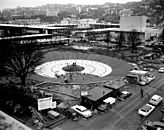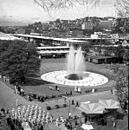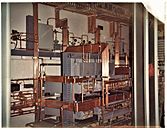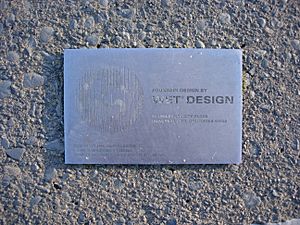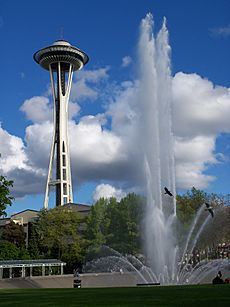International Fountain facts for kids
Quick facts for kids International Fountain |
|
|---|---|
| Public fountain | |
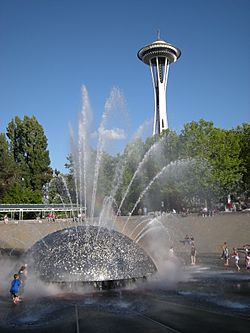 |
|
| Design: |
|
| Opening date: | 1962 |
| Owner: | City of Seattle |
| Location: | Seattle Center 305 Harrison Street, Seattle |
|
International Fountain, Seattle Center |
|
The International Fountain is a famous water fountain and sculpture located in Seattle Center in Washington. It was built for the Century 21 Exposition, also known as the Seattle World's Fair, in 1962. Two architects from Tokyo, Kazuyuki Matsushita and Hideki Shimizu, designed this amazing concrete fountain.
Designing the International Fountain
The International Fountain was built where a playground used to be. This playground, called Mercer Playground, had been there since the 1910s. When people planned the Century 21 Exposition, they decided this spot would be the main area for a special display.
At first, they thought about having a narrow lagoon with gondolas and a bridge. But then, they held a contest in 1960 to find a design for a "light, water, and sculpture display." Matsushita and Shimizu won the contest with their unique idea. They wanted the fountain to show "mankind's efforts to explore the farthest reaches of outer space." Their design focused on water jets and the cool shapes they made, instead of statues.
From the beginning, we have set about this fountain design with a view to putting sole stress upon water itself — its shape and movement — without recourse to any sculpture or accessories. ... The water which springs up from each nozzle describes a primitive, ordinary parabola. But when the parabolas are varied and gathered methodically, it shows a mighty and bountiful spectacle. Furthermore lively feeling can be expressed in the swelling curved phases of water by opening and shutting nozzle cocks at different time lag. Such beauty and might are expressed only by means of water, which may be called, in its true sense of the work, a fountain.
—Matsushita and Shimizu, Report of Seattle Civic Center Fountain Contest (c.1962)
The design contest received 261 entries from all over the world. A group of famous architects and sculptors chose five finalists. Matsushita and Shimizu were chosen as the winners. At the time, Matsuyuki Matsushita was 29 years old and Hideki Shimizu was 26.
1995 Rebuild and New Features
The fountain was updated in 1995 by a company called WET Design. Before this, the fountain had nozzles sticking out and was surrounded by white rocks. These rocks were meant to look like a "lunar landscape" (moon surface), but they also kept people from getting close to the water.
After the 1995 rebuild, the rocks were removed. The central dome was changed to have many jets that are almost flat with the surface. This made it easier for visitors to approach and play in the fountain.
The fountain's powerful pumps are located about 30 feet (9.1 m) below the ground. The water is recycled and cleaned using sand filters. At certain times of the day, the water display moves and changes to the rhythm of music. These shows can last up to twelve minutes.
Fountain Facts and Figures
When it was first built in 1962, the fountain's main pool was 185 feet (56 m) across. It had a dome 6 feet (1.8 m) high and 30 feet (9.1 m) wide with 465 nozzles. Lights on the floor lit up the fountain.
After the 1995 rebuild, the fountain's bowl became 220 feet (67 m) wide. The dome was rebuilt with stainless steel and is now 10 feet (3.0 m) tall and 27 feet (8.2 m) wide. The fountain holds about 9,000 US gallons (34,000 L) of water.
Here's how the water jets are set up now:
- 56 "Micro shooters" are hidden in the granite blocks around the edge of the fountain. They shoot straight up.
- 77 "Fleur-de-lis" nozzles are on the dome. These are about the size of a plate and shoot water in medium-high arcs.
- 4 "Super shooters" are on top of the dome. These can shoot water up to 120 feet (37 m) high! Each "super shooter" uses 66 US gallons (250 L) of water for one big shot.
- 137 "Mist nozzles" have tiny openings, like a pinhead, to create a foggy effect.
There is also another ring of floodlights between the "micro shooters" and the dome, making the fountain look even more amazing at night.


